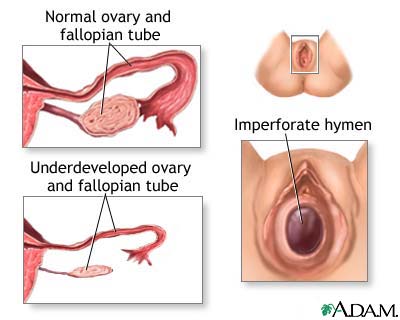Treatment
Treatment depends on the cause of the missing period. Primary amenorrhea caused by birth defects may require medications (hormones), surgery, or both.

If the amenorrhea is caused by a tumor in the brain (pituitary tumor), the tumor is usually treated with a drug called bromocriptine. Surgery to remove the tumor may also be necessary. Radiation therapy is usually only performed when other treatments have not worked.
If the condition is caused by a body-wide (systemic) disease, treatment of the disease may allow menstruation to begin.
Prognosis (Expectations)
Overall the outlook is good, depending on the cause of the amenorrhea. If the amenorrhea is caused by one of the following conditions, there is a good possibility of correcting the amenorrhea through medication, lifestyle change, or surgery:
* Normal delay of onset (up to age 14 or 15)
* Drastic weight reduction
* Hypoglycemia
* Obesity
* Hypogonadotropic hypogonadism
* Chronic illness
* Malnutrition
* Congenital heart disease
* Overactive thyroid
* Imperforate hymen
* Transverse vaginal septum
* Adrenogenital syndrome
If the amenorrhea is caused by one of the following conditions, it is unlikely that the amenorrhea can be corrected by any method:
* Congenital abnormalities of the upper genital system
* Gonadal dysgenesis
* Turner syndrome (XO)
* Testicular feminization syndrome
* True hermaphroditism
* Cystic fibrosis
* Craniopharyngioma
* Prader-Willi syndrome
If the amenorrhea cannot be corrected, it is sometimes possible to create a menstrual-like situation (pseudomenstruation) with medications to help the young woman feel more like her friends or family.
Complications
Emotional distress or crisis about being different from friends or family and about possible inability to bear children can occur.
Calling Your Health Care Provider
Call your health provider if your daughter is older than age 16 and has not yet begun menstruating, or if she is 14 and shows no other signs of puberty.
Amenorrhea – primary: Overview, Causes
Amenorrhea – primary: Symptoms & Signs, Diagnosis & Test
Amenorrhea – primary: Treatment
Reviewed By : Susan Storck, MD, FACOG, Clinical Teaching Faculty, Department of Obstetrics and Gynecology, University of Washington School of Medicine; Chief, Eastside Department of Obstetrics and Gynecology, Group Health Cooperative of Puget Sound, Redmond, Washington. Also reviewed by David Zieve, MD, MHA, Medical Director, A.D.A.M., Inc.
